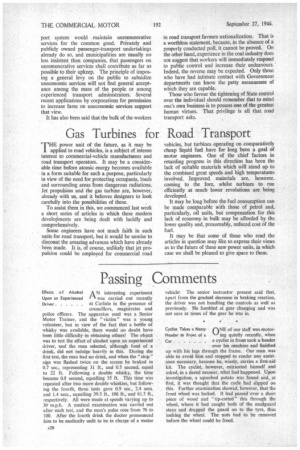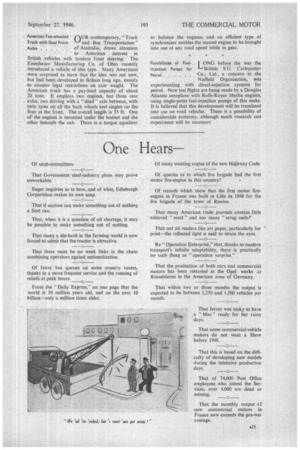Pass ing Comments Effects o f Alcohol A N interesting experiment Upon
Page 22

Page 23

If you've noticed an error in this article please click here to report it so we can fix it.
an Experienced 1--/. was carried out recently Driver at Carlisle in the presence of councillors, magistrates and police officers. The apparatus used was a Senior Motor Trainer, and the "victim" was a young volunteer, but in view of the fact that a bottle of whisky was available, there would no doubt have been little difficulty in obtaining others! The object was to test the effect of alcohol upon an experienced driver, and the man selected, although fond of a drink, did not indulge heavily in this. During the first test, the man had no drink, and when the "stop" sign was flashed twice on the screen he braked in 0.7 sec., representing 31 ft., and 0.5 second, equal to 22 ft. Following a double whisky, the time became 0.8 second, equalling 35 ft This time was repeated after two more double whiskies, but following the fourth, three tests gave 0.9 sec., 2.4 secs. and 1.4 secs., equalling 39.5 ft., 106 ft., and 61.5 ft., respectively. All were made at speeds varying up to 30 m.p.h. A medical examination was carried out after each test, and the man's pulse rose from 76 to 100. After the fourth drink the doctor pronounced him to be medically unfit to be in charge of a motor
vehicle: The senior instructor present said that, apart from the gradual decrease in braking reaction, the driver was not handling the controls as well as previously. He fumbled at gear changing and was not sure at times of the gear he was in.
Cydist Takes a Nasty nNE of our staff was motorHeader In Front of a ‘•-• ing quietly recently, when Car a cyclist in front took a header over his machine and finished up with his legs through the frame. Our man was able to avoid him and stopped to render any assistance necessary, because he, wisely, carries a first-aid kit. The cyclist, however, extricated himself and asked, in a dazed manner, what had happened. Upon .investigation, a squashed potato was found and, at first, it was thought that the cycle had slipped on this. Further examination showed, however, that the front wheel was locked. It had passed over a short piece of wood and "tip-catted" this through the wheel, where it had caught both of the mudguard stays and dragged the guard on to the tyre, thus locking the wheel. The nuts had to be removed before the wheel could be freed.
American Ten-wheeled Truck with Dual Front Axles nUR contemporary, "Truck and Bus Transportation" of Australia, draws attention to American interest in British vehicles with tandem front steering. The Eisenhauer Manufacturing Co. of Ohio recently introduced a vehicle of this type. Many Americans were surprised to learn that the idea was not new, but had been developed in Britain long ago, mainly to counter legal restrictions on axle weight. The American truck has a pay-load capacity of about 20 tons. It employs two engines, has three rear axles, two driving with a " dead " axle between, with twin tyres on all the back wheels and singles on the four at the front. The overall length is 35 ft. One of the engines is mounted under the bonnet and the other beneath the cab. There is a torque equalizer to balance the engines, and an efficient type of synchronizer enables the second engine to be brought into use at any road speed while in gear.
Possibilities of Fuelj ONG before the war the iniection Pumps for 1-4 British S.U. Carburetter
Petrol Co., Ltd., a concern in the Nuffield Organisation, was experimenting with direct-injection systems for petrol. Now test flights are being made by a Douglas Atlantic aeroplane with Rolls-Royce Merlin engines, using single-point fuel-injection pumps of this make. It believed that this development will be translated into use on road vehicles. There is a possibility of considerable economy, although much research and experiment will be necessary




































































